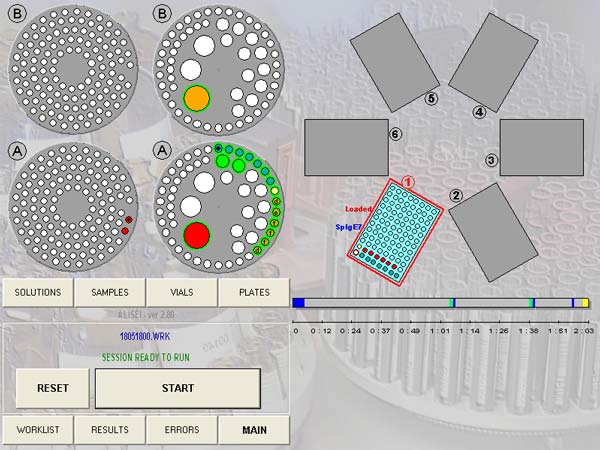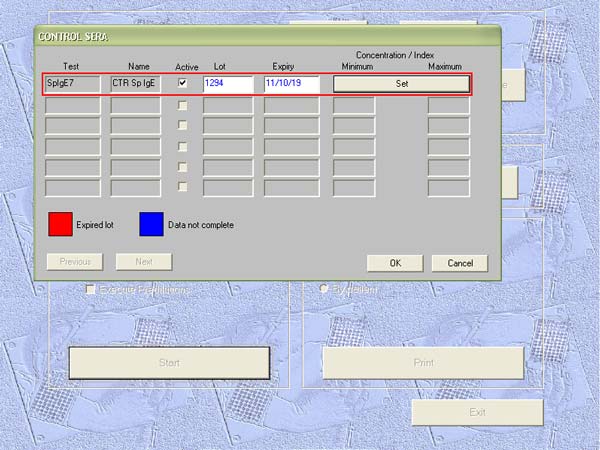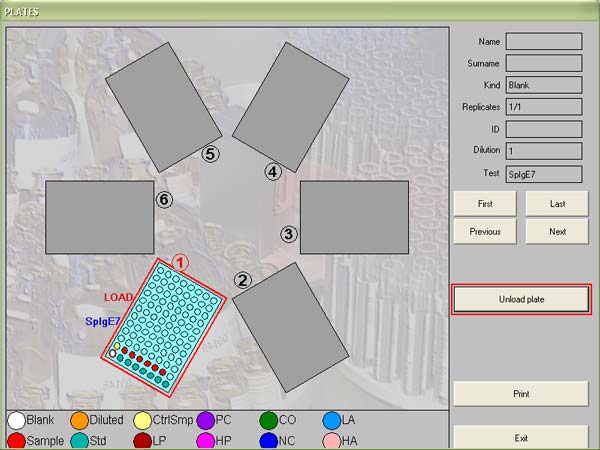- Capacity of 6 microtiter plates (ELISA)
- Walk-Away-System
- Ideal for various ELISA applications of laboratory diagnostics:
Determination of hormones, tumor markers, infectious diseases … - Up to 12 different assays at same time
- Standard curve recall and recalibration
- Time management system
- Quality control functions
- Monitoring the entire test run
- No disposable tips
- Flexible user interface
Fully automatic microtiter plates ELISA Analyzer
Solution for processing ELISA kits
Simple ‘loading’ with reagent and sample racks, which can be stored in the refrigerator.
6 microtiter plates (ELISA) are incubated, shaken and washed independently of each other
Reagents and samples
- Removable rotating racks for reagents and sample tubes
- Maximum capacity: 240 sample tubes
- Simultaneous loading of up to 12 reagent sets (or up to 81 allergens)
Multiple reagents on two separate racks can be loaded on the machine. The charging area is easily accessible for easy loading of reagents, samples and polymer tips through a transparent, large sliding window. The reagent and sample racks are easily removable with practical handles to quickly store the reagents in the refrigerator.
Double pipetting system
two independent needles
Barcode reader offers reliability
Barcode reader reads samples and reagents
Dosing and diluting
Pipettier speed serum: 700 samples/hour
Pipettier speed reagents: 1500 Wells/Hour
Liquid level detection for optimal detection of fibrin clots and insufficient volume
Incubate and mixing
The microtiter plate carousel can perform linear shaking with a programmable intensity and period for each plate separately.
8-channel washing station
Number of cycles: programmable from 1 to 9 cycles
Impact time: programmable from 1 second to 3 minutes
Pressure: programmable
Each protocol can be programmed by the operator with multiple washes that differ in cycle, volume, holding time, and pressure.
Alisei Q.S.: 8-channel washing station
Reading
The normally provided filters: 405, 450, 492, 550 and 620 nm
Reader range: 0-3 OD in Bichromatism; 0-9 OD in polychromatism
Alisei Q.S.: 8-channel photometer
Equipment maintenance
Preparation and follow-up of working time: 5 minutes per day
No warm-up phase required.
Self-diagnostic and alarm procedures are an essential part of the Alisei Q.S..
daily
Cleaning at the end of the run – fully automatic.
weekly
General cleaning of the workspace of liquids.
Empty all tanks to remove residual buffers. Rinse with DI water.
Empty all tanks to remove residual buffers. Rinse with DI water.
monthly
Wipe off the work area, plate trays, and waste bin.
Check tanks and visible hoses
Check tanks and visible hoses
Smart software
- Programming and changing test protocols
- Insert work lists with all relevant patient data
- Monitoring the entire test run
- View and manage the final results
- Personalizing and printing the patient report
- Standard curve retrieval function
- T. M. S. (Time Management System)
- Quality control functions
- Compatible with laboratory information systems
ELISA results manager
Logistic curve-based parametric methods such as 4-parameter logistics (4PL) and Live Parameter Logistic (5PL) models have the closest correlation with real signal concentration dependence in ELISA assays.
The calculated results based on these methods have very little variability and high reproducibility. Therefore, they are considered the most suitable models for both competitive and “sandwich” ELISAs viewed. However, these calculation modes are not always available in the standard equipment software for demonstrating the ELISA test results. In this case, the ELISA Results Manager software provides an upgrade of the results analysis.
Key program benefits:
- Calculating results based on 4PL and 5PL models
- Visualization of the calibration curves
- Simplified information entry
- Processing the data received on an ELISA device
- Calculation of sample concentrations and statistics
- Printable results
Technical specifications Alisei Q.S.
Dosing
microtiter plates:
6
Parameter:
max. 12 in one run
Samples:
max. 360 in one run
Pipetting volume:
7 µL – 1000 µL
Precision tip 10 µL:
less than 2.5%
Tipp 100 µL:
less than 1%
Needle:
less than 1.5%
Throughput samples:
700 / h (500 µL washing)
Throughput reagents:
1400 Wells / h
Fill level sensor:
Capazitive for needle
Incubators:
6
Temperature:
RT / RT +5 °C bis +45 °C
Heating time:
5 min
Washing
Buffer:
4 with filler stander recognition
Stations:
1
Liquid trap:
10L with “Full” sensor
Photometer
Units:
1
Reading:
from 0-3 OD (mono / dual / triple wavelength)
Spectral range:
400 – 700 nm
Interference filters:
5
Software
Operating system:
Windows 10
Interface:
Bidirectional ASTM (LIS compatible)
Internal quality control:
Levey Jennings and Westguard rules
Data reduction:
Standard interpolations
Dimensions
Depth:
73 cm
Height:
60 cm
Width:
140 cm
Weight:
100 kg
Electrical specifications
Voltage:
110 or 220 V AC
Frequency:
50-60 Hz
Power:
800 VA










